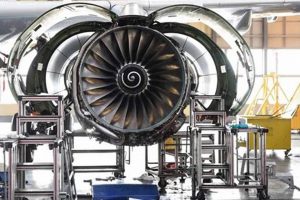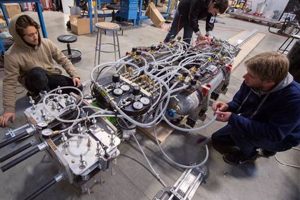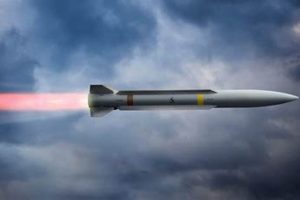Representations of significant figures, achievements, or symbols deeply associated with the field of flight and space exploration serve as embodiments of its core principles and aspirations. For example, the Wright brothers’ first successful airplane, the Saturn V rocket, or pioneering engineers like Kelly Johnson often evoke images of innovation, ingenuity, and the relentless pursuit of pushing boundaries within the aeronautical and astronautical domains.
These prominent figures and pivotal inventions inspire future generations, fostering a sense of pride and dedication within the aerospace community. They provide a tangible connection to the past, demonstrating the evolution of the field and underscoring the potential for continued progress. Furthermore, the recognition and celebration of such achievements encourage ongoing investment in research, development, and education, leading to further advancements in the technologies that define air and space travel.
The following discussion will delve into specific individuals, landmark projects, and defining symbols that have significantly shaped and continue to influence the trajectory of the aerospace industry, impacting areas such as aircraft design, propulsion systems, and space exploration initiatives.
Guidance From Exemplars of Aerospace Engineering
Drawing upon the established practices and demonstrated success of individuals and projects considered benchmarks within the aerospace field, several crucial guidelines emerge for aspiring engineers and ongoing projects.
Tip 1: Prioritize Rigorous Testing: Emulate the meticulous testing protocols employed throughout the development of successful aircraft and spacecraft. Extensive simulations, wind tunnel experiments, and component-level testing are paramount to identifying potential design flaws and ensuring operational reliability.
Tip 2: Embrace Interdisciplinary Collaboration: Recognize the interconnectedness of various engineering disciplines within aerospace. Effective communication and collaboration between aerodynamicists, structural engineers, propulsion specialists, and control systems engineers are essential for holistic design optimization.
Tip 3: Focus on Safety and Reliability: Uphold the highest standards of safety in all design and operational aspects. Redundancy in critical systems, fault-tolerant designs, and robust safety protocols are non-negotiable prerequisites for successful aerospace endeavors.
Tip 4: Drive Innovation Through Research: Cultivate a culture of continuous learning and exploration. Stay abreast of the latest advancements in materials science, propulsion technologies, and computational methods. Actively pursue research and development initiatives to push the boundaries of what is currently achievable.
Tip 5: Document Thoroughly: Maintain meticulous records of all design decisions, test results, and modifications made throughout the development process. Comprehensive documentation is crucial for traceability, troubleshooting, and future design iterations.
Tip 6: Master Fundamentals: Possess a deep understanding of the fundamental principles of physics, mathematics, and engineering relevant to aerospace. A strong foundation in these areas is essential for effective problem-solving and innovative design solutions.
Tip 7: Accept Failure as a Learning Opportunity: View setbacks not as defeats, but as opportunities for growth and improvement. Analyze failures thoroughly to identify root causes and implement corrective actions to prevent recurrence.
Adherence to these principles, inspired by the achievements of prominent figures and groundbreaking projects, fosters a culture of excellence and significantly increases the likelihood of success in the demanding field of aerospace engineering.
The following sections will further explore the practical applications of these guidelines within specific areas of aerospace design and development.
1. Inspirational Leadership
Inspirational leadership serves as a fundamental element in the development and recognition of significant figures within aerospace engineering. Leaders in this field often possess the ability to articulate a compelling vision, motivating teams to achieve ambitious goals and overcome complex technical challenges. This capability is crucial for fostering innovation and driving progress. The presence of inspirational leadership is frequently observed as a contributing factor in the success of groundbreaking projects, highlighting its importance as a characteristic attribute of those recognized as noteworthy contributors.
Consider, for instance, the leadership displayed by Wernher von Braun during the Apollo program. His technical expertise, combined with his capacity to inspire a vast team of engineers and scientists, was instrumental in achieving the lunar landing. He provided a clear direction, fostered collaboration, and instilled a sense of purpose that transcended individual roles. The impact of such leadership extends beyond the immediate project, influencing the organizational culture and shaping the trajectory of future aerospace endeavors. Similarly, figures like Clarence “Kelly” Johnson at Lockheed’s Skunk Works demonstrated how a clear vision, combined with a demanding but motivating approach, could lead to the development of revolutionary aircraft like the SR-71 Blackbird.
In essence, the capacity to inspire others, communicate a compelling vision, and foster a collaborative environment is a recurring theme among individuals widely recognized for their contributions to aerospace engineering. This form of leadership is not merely about directing tasks; it’s about cultivating a shared commitment to excellence and innovation, thereby establishing a lasting legacy that contributes to the ongoing advancement of the field.
2. Technical Innovation
Technical innovation represents a cornerstone in establishing individuals, projects, and technologies as noteworthy within aerospace engineering. Without sustained advancements in design, materials, propulsion, and control systems, progress within the field stagnates. Consequently, the ability to conceive, develop, and implement groundbreaking solutions directly correlates with recognition and lasting impact.
- Breakthrough Designs
Innovative configurations, such as the swept-wing design pioneered by Robert T. Jones, fundamentally altered aircraft performance. The adoption of this design enabled aircraft to achieve significantly higher speeds, directly impacting both military and commercial aviation. Such transformative designs cement the legacy of their creators and the projects that utilize them.
- Advanced Materials
The development and application of new materials, including lightweight composites and heat-resistant alloys, are essential for enhancing aircraft and spacecraft capabilities. The utilization of titanium in the SR-71 Blackbird, for instance, allowed for sustained high-speed flight. The creation and effective deployment of such materials often defines the leading edge of aerospace technology.
- Propulsion Systems
Significant advancements in propulsion technology, such as the development of the turbofan engine, have revolutionized air travel by improving fuel efficiency and increasing range. Similarly, the development of high-performance rocket engines, like the Saturn V’s F-1 engine, were essential for lunar missions. These advancements in propulsion directly translate into expanded operational capabilities and are hallmarks of engineering achievement.
- Control and Navigation Systems
The integration of sophisticated control and navigation systems, including fly-by-wire technology and GPS-based navigation, has greatly enhanced aircraft safety and operational efficiency. The development of autonomous flight control systems for unmanned aerial vehicles (UAVs) has expanded the range of potential applications. These advancements are crucial for modern aerospace operations and are often indicative of the field’s future direction.
These examples demonstrate the critical role technical innovation plays in defining significant achievements and influential figures in aerospace engineering. Each advancement, from breakthrough designs to sophisticated control systems, contributes to pushing the boundaries of what is possible and shaping the trajectory of the field. Those who consistently drive such innovation are frequently recognized for their contributions and leave a lasting mark on the industry.
3. Enduring Legacy
The concept of an enduring legacy is intrinsically linked to recognition within aerospace engineering. Lasting contributions, whether through innovation, leadership, or fundamental advancements, determine the long-term impact and significance of individuals and projects. It’s the creation of this tangible and lasting effect on the industry that solidifies their position.
- Educational and Mentorship Influence
The dissemination of knowledge and the guidance of future generations are essential components of a lasting legacy. Individuals who actively contribute to aerospace education, mentor young engineers, and inspire future leaders leave an enduring mark on the field. Their influence extends beyond their direct contributions, shaping the trajectory of future innovation.
- Technological Advancements and Impact
The development of transformative technologies and their widespread adoption within the aerospace sector contribute significantly to an enduring legacy. Innovations that address critical challenges, improve performance, or enhance safety have a long-lasting impact on the design, operation, and capabilities of aircraft and spacecraft. The widespread influence and prolonged relevance of a technological advancement directly correlate with its contribution to a lasting legacy.
- Contribution to Industry Standards and Practices
Individuals and projects that influence the establishment of industry standards and best practices have a profound and lasting impact on the field. Their work shapes the norms, regulations, and methodologies used in aerospace engineering, contributing to enhanced safety, efficiency, and reliability. The widespread adoption of these standards solidifies their contribution to the enduring legacy of aerospace engineering practices.
- Inspiring Future Innovation
Works which encourage continuous improvement are invaluable for future growth. By setting the precedent with a high bar, more and more developments can occur.
These multifaceted contributions, from fostering education to setting industry standards, highlight the critical role of enduring legacy in shaping the recognition and lasting influence of those who define aerospace engineering. The ability to leave a positive, sustainable, and impactful mark on the field is a defining characteristic.
4. Problem Solving
Problem solving is inextricably linked to the concept, representing a core skill and essential characteristic that defines influential figures and pivotal projects within the field. The ability to effectively address complex technical challenges and navigate unforeseen obstacles is a consistent theme among those recognized for their contributions to aerospace engineering, making it an integral attribute of any engineering legend.
- Systematic Analysis and Deconstruction
Complex aerospace problems demand rigorous analysis and deconstruction into manageable components. Identifying root causes, understanding interdependencies, and establishing clear objectives are critical first steps. An example is the development of thermal protection systems for spacecraft re-entry, where engineers systematically analyzed the physics of atmospheric entry, identified critical thermal loads, and designed solutions to mitigate extreme heat.
- Creative Design and Innovative Solutions
Beyond analysis, the generation of creative design concepts and innovative solutions distinguishes true problem-solvers. This involves exploring unconventional approaches, challenging established assumptions, and integrating knowledge from diverse disciplines. The design of the variable-sweep wing for the F-111 fighter bomber demonstrates creative problem-solving, enabling both high-speed and efficient low-speed flight.
- Iterative Testing and Refinement
Aerospace engineering relies on iterative testing and refinement to validate solutions and identify unforeseen issues. This involves rigorous simulations, wind tunnel experiments, and flight testing to continuously improve designs. The development of modern aircraft flight control systems demonstrates this process, with engineers iteratively testing and refining algorithms to ensure stability and performance across a wide range of flight conditions.
- Adaptive Response to Unforeseen Challenges
The ability to adapt to unforeseen challenges and respond effectively to unexpected circumstances is a hallmark of proficient problem-solvers. This requires a flexible mindset, a willingness to learn from failures, and the capacity to improvise when necessary. The Apollo 13 mission serves as a prime example, where engineers on the ground and astronauts in space collaboratively developed innovative solutions to overcome critical system failures and ensure the crew’s safe return.
These facets systematic analysis, creative design, iterative testing, and adaptive response collectively represent the problem-solving acumen that defines individuals and projects considered icons. The capacity to navigate complexity, develop innovative solutions, and adapt to unforeseen challenges is a defining characteristic, solidifying their place within the legacy of aerospace engineering.
5. Pioneering Spirit
The pioneering spirit serves as a fundamental impetus in aerospace engineering, directly influencing the recognition and enduring legacy of individuals, projects, and technological advancements. This spirit, characterized by a relentless pursuit of the unknown, a willingness to challenge established norms, and a dedication to exploring uncharted territories, forms a critical component of what constitutes an “aerospace engineering icon.” Without this inherent drive to push boundaries, the field would stagnate, unable to achieve the breakthroughs that define progress. The constant pursuit of advancements relies on the pioneering spirit to reach new heights.
Consider, for instance, the early aviators who dared to defy gravity with rudimentary machines. Their unwavering belief in the possibility of flight, coupled with their willingness to risk personal safety, paved the way for modern aviation. Similarly, the engineers and scientists behind the space race, driven by a desire to explore the cosmos, overcame immense technical challenges to achieve feats previously considered impossible. The development of reusable spacecraft, spearheaded by individuals with a vision for sustainable space access, represents another manifestation of this spirit. These examples illustrate how the pioneering spirit directly translates into tangible advancements, ultimately shaping the landscape of the industry. The absence of such spirit would negate the progress of the aerospace.
In conclusion, the pioneering spirit is not merely a desirable attribute but a necessary ingredient for progress in aerospace engineering. This drive to explore, innovate, and overcome challenges defines the individuals and projects considered legendary. Understanding this connection is crucial for fostering a culture of innovation and inspiring future generations to continue pushing the boundaries of aerospace technology, ensuring the ongoing advancement and evolution of this critical field.
6. Safety Advocacy
Safety advocacy within aerospace engineering represents a paramount concern that significantly influences the recognition and legacy of individuals and projects. A proactive and unwavering commitment to safety, extending beyond mere compliance with regulations, is a defining characteristic associated with figures considered to be exemplary within the field. This commitment directly impacts public trust, mission success, and the long-term viability of aerospace endeavors.
- Development of Robust Safety Protocols
The creation and implementation of comprehensive safety protocols are essential for mitigating risks across all phases of aerospace operations, from design and manufacturing to flight testing and routine operations. This involves identifying potential hazards, establishing preventive measures, and developing contingency plans for unforeseen events. The meticulous development of safety protocols for commercial aviation, for instance, has significantly reduced accident rates, demonstrating the tangible benefits of proactive safety advocacy.
- Prioritization of Redundancy and Fail-Safe Mechanisms
Incorporating redundancy in critical systems and implementing fail-safe mechanisms are crucial strategies for enhancing safety and minimizing the consequences of component failures. This approach ensures that if one system fails, backup systems are in place to maintain functionality and prevent catastrophic outcomes. The design of multiple redundant systems in spacecraft life support exemplifies this principle, safeguarding the lives of astronauts in the event of equipment malfunction.
- Promotion of Safety Culture and Education
Cultivating a strong safety culture within aerospace organizations is paramount for fostering a proactive approach to risk management and ensuring that all personnel prioritize safety in their daily activities. This involves providing comprehensive training, encouraging open communication about potential hazards, and empowering individuals to report safety concerns without fear of reprisal. The establishment of robust safety reporting systems in the nuclear power industry, coupled with extensive safety training programs, demonstrates the effectiveness of a strong safety culture in preventing accidents.
- Championing Regulatory Compliance and Ethical Practices
Adhering to established regulatory frameworks and upholding ethical standards are fundamental aspects of safety advocacy in aerospace engineering. This involves complying with all applicable regulations, conducting thorough safety audits, and promoting transparency in all operations. The implementation of strict environmental regulations in the automotive industry, requiring manufacturers to reduce emissions and improve fuel efficiency, demonstrates the impact of regulatory compliance in promoting safety and sustainability.
These interconnected facetsrobust protocols, redundancy, culture, and compliance underscore the integral role of safety advocacy in shaping perceptions. Figures and initiatives that demonstrably prioritize safety earn respect, enhancing credibility and long-term influence within aerospace engineering.
7. Systems Thinking
Systems thinking is a crucial framework for understanding and appreciating those who achieve recognition within the field. Aerospace projects are inherently complex, involving the integration of numerous interconnected subsystems. Therefore, individuals who can effectively grasp these intricate relationships, anticipate potential cascading effects, and optimize overall system performance are highly valued and more likely to leave a lasting impact.
- Holistic Perspective and Interdependency Awareness
A systems-oriented approach necessitates a comprehensive understanding of how various components interact within a complex aerospace system. It moves beyond a focus on individual parts to consider the emergent behavior arising from the interplay between them. The design of an aircraft, for example, requires considering not only the aerodynamics of the wings but also the structural integrity of the fuselage, the performance of the propulsion system, and the stability of the flight control system. Failure to account for these interdependencies can lead to catastrophic consequences.
- Lifecycle Considerations and Long-Term Impact
Systems thinking emphasizes the importance of considering the entire lifecycle of an aerospace system, from initial design and development to manufacturing, operation, maintenance, and eventual decommissioning. This perspective necessitates evaluating the long-term environmental, economic, and social impacts of aerospace activities. For example, designing more fuel-efficient aircraft reduces greenhouse gas emissions and contributes to a more sustainable aviation industry. Similarly, developing robust maintenance procedures minimizes downtime and extends the operational life of aerospace assets.
- Trade-off Analysis and Optimization
Aerospace engineering often involves making difficult trade-offs between competing objectives. Systems thinking provides a framework for analyzing these trade-offs and identifying optimal solutions that balance performance, cost, reliability, and safety. For example, designing a spacecraft for interplanetary travel involves balancing the need for high propulsion efficiency with the constraints of limited fuel capacity and long mission durations. Similarly, developing autonomous flight control systems requires balancing the desire for increased automation with the need for human oversight and control.
- Emergent Behavior and Unintended Consequences
Complex systems often exhibit emergent behavior, which refers to unexpected and unpredictable outcomes arising from the interactions between individual components. Systems thinking encourages the anticipation and mitigation of potential unintended consequences through rigorous analysis and testing. The implementation of new air traffic control systems, for instance, requires careful consideration of potential disruptions to existing operations and the development of contingency plans to address unforeseen challenges.
These facets interdependency awareness, lifecycle considerations, trade-off analysis, and awareness of emergent behaviorhighlight the critical role of systems thinking in shaping perceptions of accomplishments within aerospace engineering. Individuals and initiatives that demonstrate a strong grasp of these principles, contributing to enhanced effectiveness, reliability, and safety, are frequently recognized. The ability to holistically incorporate these factors cements the significance of individuals and projects.
Frequently Asked Questions
This section addresses common inquiries and clarifies misconceptions related to individuals, projects, and symbols considered benchmarks within the field of aerospace engineering.
Question 1: What specific attributes characterize an “aerospace engineering icon?”
Attributes include demonstrated technical innovation, inspirational leadership, the creation of an enduring legacy, exceptional problem-solving skills, a pioneering spirit, unwavering safety advocacy, and proficiency in systems thinking. These are not mutually exclusive; often, a combination of these qualities is observed.
Question 2: How does the concept of “enduring legacy” contribute to the recognition of individuals in aerospace engineering?
An enduring legacy involves leaving a tangible and lasting impact on the field, whether through mentorship of future generations, the development of transformative technologies, or the establishment of industry standards. Contributions must have a prolonged influence to be considered part of an enduring legacy.
Question 3: Why is problem-solving ability considered essential for those recognized as “aerospace engineering icons?”
Aerospace engineering projects inherently involve complex technical challenges. The ability to systematically analyze problems, develop innovative solutions, and adapt to unforeseen circumstances is crucial for success and, therefore, a hallmark of individuals considered exemplary within the field.
Question 4: How does a “pioneering spirit” contribute to advancements in aerospace engineering?
A pioneering spirit, characterized by a willingness to challenge established norms and explore uncharted territories, drives innovation and enables the development of groundbreaking technologies. This spirit is essential for pushing the boundaries of what is currently achievable and shaping the future of the field.
Question 5: What is the significance of “safety advocacy” in the context of aerospace engineering achievements?
A proactive and unwavering commitment to safety is paramount for ensuring mission success, protecting public trust, and maintaining the long-term viability of aerospace endeavors. Prioritizing safety, beyond mere compliance, is a key attribute of individuals and projects considered benchmarks.
Question 6: How does “systems thinking” contribute to the effectiveness of aerospace engineers and projects?
Systems thinking enables engineers to understand the complex interdependencies within aerospace systems, anticipate potential consequences, and optimize overall system performance. This holistic perspective is crucial for addressing the multifaceted challenges inherent in aerospace projects.
In summary, the attributes of technical innovation, inspirational leadership, enduring legacy, problem-solving skills, pioneering spirit, safety advocacy, and systems thinking collectively define figures recognized as exemplary. The integration of these elements allows for lasting achievements and positive contributions to the aerospace field.
The following section will examine specific case studies of figures and initiatives widely considered to embody these iconic characteristics.
Conclusion
This exploration of characteristics inherent to those recognized as an “aerospace engineering icon” underscores the multifaceted nature of lasting influence within the field. Demonstrated technical innovation, inspirational leadership, the creation of an enduring legacy, exceptional problem-solving skills, a pioneering spirit, unwavering safety advocacy, and proficiency in systems thinking collectively define the individuals, projects, and symbols that have shaped, and continue to shape, aerospace engineering.
The study of these exemplary figures and their accomplishments serves as a valuable resource for aspiring engineers and ongoing projects. By embracing these principles and striving for excellence in all aspects of aerospace design, development, and operation, future generations can contribute to the continued advancement of air and space travel, ensuring the ongoing progress and safety of the field.







